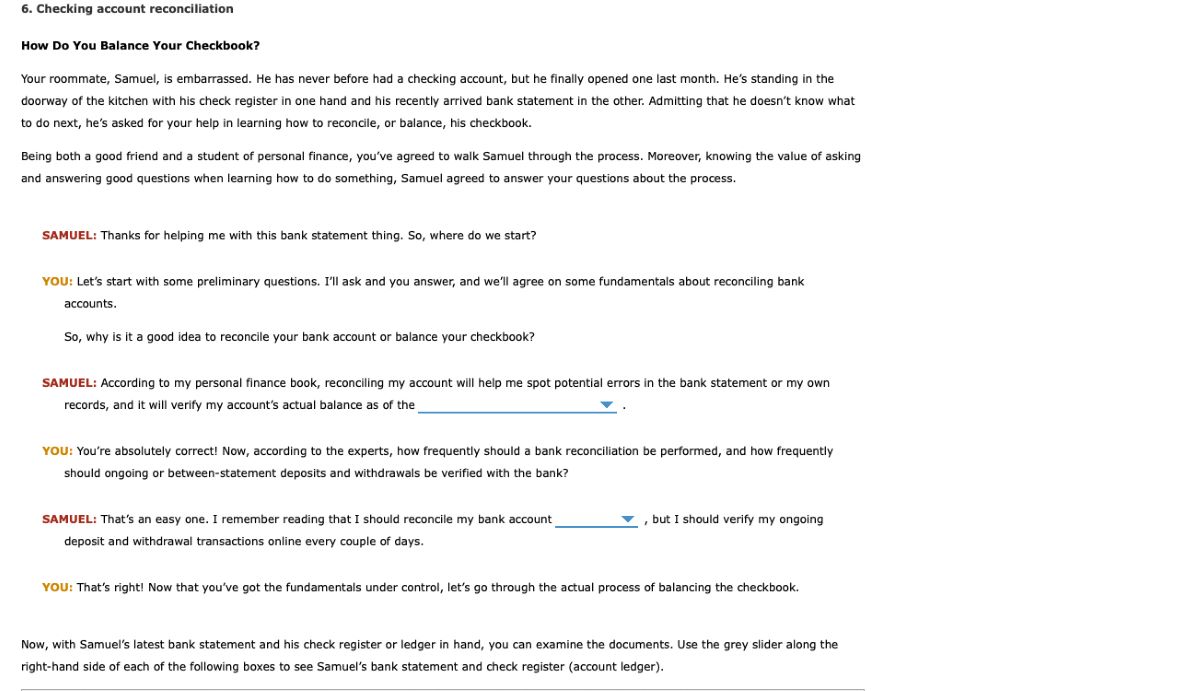

Finance
How Often Should You Check Your Stocks
Published: January 18, 2024
Learn how often you should check your stocks in order to stay on top of your finance game and make informed investment decisions.
(Many of the links in this article redirect to a specific reviewed product. Your purchase of these products through affiliate links helps to generate commission for LiveWell, at no extra cost. Learn more)
Table of Contents
- Introduction
- Importance of Monitoring Stocks
- Factors to Consider in Determining Monitoring Frequency
- Short-Term Trading vs. Long-Term Investing
- Common Techniques for Monitoring Stocks
- Setting Up Alerts and Notifications
- Balancing Monitoring with Long-Term Strategy
- Expert Recommendations on Monitoring Frequency
- Conclusion
Introduction
Investing in the stock market can be an exhilarating and potentially lucrative endeavor. As investors, we put our hard-earned money into stocks with the hope of seeing them grow and provide meaningful returns. However, investing in stocks also comes with the responsibility of monitoring and managing our investments.
Monitoring stocks is crucial because the stock market is dynamic and constantly changing. Stocks can rise or fall in value within a matter of hours, and as investors, it’s important to stay informed about these fluctuations. Monitoring stocks allows us to make informed decisions about when to buy or sell, based on market trends, financial news, and other relevant factors.
But just how often should you check your stocks? Is it necessary to monitor them every day, or can you get away with checking them less frequently? The answer may depend on various factors, including your investment goals, risk tolerance, and time availability.
In this article, we will explore the importance of monitoring stocks and discuss the factors to consider in determining how often you should check your stocks. We will also highlight the differences between short-term trading and long-term investing and provide some common techniques for monitoring stocks. Additionally, we will provide expert recommendations on monitoring frequency and offer tips on finding the right balance between monitoring and maintaining a long-term investment strategy.
So, whether you’re an active trader or a passive investor, read on to discover how you can effectively monitor your stocks and stay ahead of the game in the dynamic world of investing.
Importance of Monitoring Stocks
Monitoring stocks is an essential aspect of successful investing. It allows investors to stay informed about the performance of their portfolio and make informed decisions based on current market conditions. Here are some key reasons why monitoring stocks is important:
- Market Volatility: The stock market is inherently volatile, with prices fluctuating throughout the day. By actively monitoring your stocks, you can be aware of any sudden market movements and take appropriate action to protect your investments or capitalize on potential opportunities.
- Company News and Events: Monitoring stocks enables you to stay updated on the latest news and events related to the companies you have invested in. Earnings reports, mergers and acquisitions, regulatory changes, and other significant developments can have a significant impact on stock prices. By keeping a close eye on these events, you can make timely decisions and adjust your investment strategy accordingly.
- Take Advantage of Opportunities: The stock market presents numerous opportunities for buying low and selling high. By monitoring stocks regularly, you can identify undervalued stocks or potential breakout candidates and take action before the markets catch on. This proactive approach can help you maximize your return on investment and capitalize on market inefficiencies.
- Manage Risk: Monitoring stocks allows you to manage risk effectively. By closely following the performance of your stocks, you can identify potential warning signs or signs of underperformance. This enables you to mitigate losses by making timely sell decisions or implementing risk management strategies to protect your investments.
While the importance of monitoring stocks is clear, it is equally important to strike a balance. Constantly checking your stocks can lead to over-analyzing and impulsive decision-making, which can be detrimental to your investment strategy. It is important to approach stock monitoring with a long-term perspective and avoid getting caught up in short-term market fluctuations.
In the next section, we will explore the factors to consider in determining how often you should check your stocks, taking into account your investment goals, risk tolerance, and time availability.
Factors to Consider in Determining Monitoring Frequency
Determining how often you should check your stocks largely depends on several factors that are unique to your individual circumstances and investment goals. Here are some important factors to consider when determining the frequency of monitoring your stocks:
- Investment Goals: Consider your investment goals and time horizon. Are you a short-term trader looking for quick profits, or a long-term investor focused on building wealth over time? Short-term traders may need to monitor their stocks more frequently to identify short-term trends and opportunities, while long-term investors can afford to check their stocks less often, focusing more on the overall market conditions and fundamental factors.
- Risk Tolerance: Your risk tolerance plays a vital role in determining your monitoring frequency. If you have a higher tolerance for risk and are comfortable with market volatility, you might feel more inclined to monitor your stocks frequently to take advantage of short-term fluctuations. On the other hand, if you have a lower risk tolerance and prefer a more stable investment approach, you may opt for less frequent monitoring to avoid getting caught up in day-to-day market noise.
- Time Availability: Consider how much time you can dedicate to monitoring your stocks. Some individuals have the luxury of spending several hours a day analyzing the market and tracking their investments, while others have limited time due to work or other commitments. It’s important to choose a monitoring frequency that aligns with your available time and resources.
- Portfolio Size: The size of your investment portfolio can also influence how often you should check your stocks. If you have a larger portfolio with diversified holdings, you may not need to monitor each stock as frequently as someone with a smaller concentrated portfolio. You can focus more on tracking the overall performance of your portfolio and making adjustments accordingly.
- Trading Style: Your trading style, whether it’s active trading, swing trading, or passive investing, can also impact your monitoring frequency. Active traders who frequently buy and sell stocks may need to monitor their holdings daily to capture short-term trading opportunities. Swing traders might check their stocks and market conditions several times a week, while passive investors who take a hands-off approach may only need to monitor their stocks on a monthly or quarterly basis.
By considering these factors and understanding your unique circumstances, you can determine the monitoring frequency that aligns with your investment objectives and personal preferences. Striking a balance between staying informed and maintaining a disciplined strategy will help you make prudent investment decisions.
In the next section, we will dive deeper into the differences between short-term trading and long-term investing and how they can impact your monitoring approach.
Short-Term Trading vs. Long-Term Investing
When it comes to monitoring stocks, it’s important to understand the differences between short-term trading and long-term investing, as they have distinct approaches and monitoring requirements.
Short-term trading: Short-term traders aim to profit from short-term price movements in the market. They often take advantage of market volatility and technical analysis to make quick buy and sell decisions. Short-term traders typically monitor their stocks closely, sometimes on a daily or even hourly basis. They focus on identifying short-term trends, chart patterns, and other technical indicators to make timely trading decisions.
Long-term investing: Long-term investing, on the other hand, is a strategy where investors aim for sustained growth over an extended period. Long-term investors typically have a buy-and-hold approach, focusing on the underlying fundamentals of the companies they invest in. They often prioritize broad market trends, economic indicators, and company performance over short-term fluctuations. Long-term investors may check their stocks less frequently, sometimes on a monthly or quarterly basis, as they are more concerned with long-term growth rather than day-to-day price movements.
While short-term traders require more frequent monitoring and active decision-making, long-term investors can afford to take a more passive approach. Long-term investors are focused on the big picture rather than the daily ups and downs of the market.
However, even as a long-term investor, it is essential to review your portfolio periodically to ensure that your investments are aligned with your long-term goals. Checking your stocks on a regular basis helps you stay informed about any major changes in the company’s financials, management, or industry dynamics that might impact its long-term prospects.
It’s worth noting that while short-term trading can be lucrative for some, it requires a significant amount of time, skill, and discipline. It is generally not recommended for inexperienced investors or those who don’t have the time or resources to dedicate to active trading.
In the next section, we will discuss some common techniques for monitoring stocks, regardless of whether you are a short-term trader or a long-term investor.
Common Techniques for Monitoring Stocks
Monitoring stocks effectively requires the use of various techniques and tools to stay informed about market trends, company performance, and other relevant factors. Regardless of whether you are a short-term trader or a long-term investor, here are some common techniques for monitoring stocks:
- News and Financial Websites: Stay up-to-date with the latest financial news and developments by regularly visiting reputable websites that provide stock market news, analysis, and information. Websites like CNBC, Bloomberg, and Reuters offer real-time updates on market trends, company announcements, and economic indicators that can impact stock prices.
- Company Reports and Filings: Review company reports, such as quarterly earnings reports, annual reports, and other regulatory filings, to gain insights into a company’s financial health, growth prospects, and strategic initiatives. These reports often provide detailed information about revenue, earnings, key performance indicators, and risks associated with the company’s operations.
- Technical Analysis: For those engaged in short-term trading, technical analysis tools can be invaluable. Technical analysis involves analyzing patterns, trends, and indicators on price charts to identify potential entry and exit points. Charting platforms, such as TradingView and StockCharts, provide a wide range of technical analysis tools to help traders make informed decisions based on historical price patterns and market trends.
- Financial Ratios and Fundamental Analysis: Fundamental analysis involves evaluating a company’s financial statements, industry trends, competitive positioning, and other factors to assess its intrinsic value. Utilize financial ratios, such as price-to-earnings (P/E), price-to-sales (P/S), and return on equity (ROE), to gauge a company’s valuation and compare it to its peers. Tools like Yahoo Finance and Google Finance provide access to financial statements, key ratios, and other fundamental data.
- Stock Screeners: Stock screeners allow you to filter stocks based on specific criteria, such as market capitalization, industry, earnings growth, and dividend yield. These tools help you identify stocks that meet your investment criteria and save time in researching individual stocks. Popular stock screeners include Finviz, Zacks, and Yahoo Finance.
By utilizing these techniques, you can stay informed about your investments, track market trends, and make informed decisions about buying, selling, or holding stocks.
Additionally, setting up alerts and notifications can be a helpful way to stay updated on specific stocks or market conditions. We will discuss this further in the next section.
Setting Up Alerts and Notifications
Setting up alerts and notifications is a convenient and efficient way to stay informed about your stocks and be notified of important market events. Whether you are a short-term trader or a long-term investor, here are some methods you can use to set up alerts and notifications:
- Email Alerts: Many financial platforms and brokerage accounts allow you to set up email alerts for specific stocks or portfolio changes. You can customize these alerts to notify you when a stock reaches a certain price level, when there is a significant news release, or when there are changes in your portfolio’s value. Email alerts ensure that you receive important information directly in your inbox, keeping you updated without the need to actively monitor the markets.
- Mobile Apps and Push Notifications: Mobile apps provided by brokerage firms, financial news platforms, and stock market tracking apps offer push notifications to keep you informed on-the-go. You can configure these apps to send you real-time alerts when there are price movements, news updates, or other events related to your selected stocks. Push notifications provide immediate updates directly on your mobile device, ensuring that you don’t miss any critical information.
- SMS Alerts: Some brokerage firms and financial services providers offer SMS alerts, where you can receive text messages for specific stock price or portfolio changes. SMS alerts are particularly useful if you prefer to receive concise, real-time information directly on your mobile phone without the need for an internet connection.
- News Aggregators: Utilize news aggregators or RSS feeds to consolidate news and updates related to your stocks or industries of interest. You can customize your feeds and receive notifications whenever there are new articles or press releases published about your selected stocks. This allows you to stay informed about the latest developments without visiting multiple websites.
- Social Media and Stock Forums: Join online communities, forums, and social media groups dedicated to stock market discussions. These platforms often have active discussions about specific stocks or sectors, and members may share timely news, analysis, or insights. By following these communities or setting up notifications for relevant discussions, you can stay updated on discussions and new information related to your investments.
Setting up alerts and notifications helps you stay on top of your investments while reducing the need for constant monitoring. It allows you to efficiently receive relevant information and react promptly to market events or changes in your stocks.
However, it’s important to strike a balance and not rely solely on alerts and notifications. Regularly reviewing and analyzing the information behind these alerts is crucial for making informed investment decisions. Alerts and notifications should be seen as a supplement to your monitoring strategy, rather than a replacement for comprehensive research and analysis.
In the next section, we will discuss the importance of balancing monitoring with a long-term investment strategy.
Balancing Monitoring with Long-Term Strategy
While it’s important to stay informed about your investments by monitoring stocks, it’s equally critical to strike a balance between monitoring and maintaining a long-term investment strategy. Here are some key considerations to help you balance monitoring with your long-term investment goals:
- Stick to Your Investment Plan: Develop a well-defined investment plan that aligns with your goals, risk tolerance, and time horizon. Your plan should outline your asset allocation, diversification strategy, and target investment timeline. By having a clear plan in place, you can resist the temptation to make impulsive and unnecessary changes to your portfolio based on short-term market fluctuations.
- Avoid Overtrading: Constantly checking your stocks and making frequent trades can lead to overtrading, which often results in transaction costs and subpar returns. Overtrading can also lead to emotional decision-making, as you may be reactive to short-term market movements rather than focusing on the long-term prospects of your investments. Remember that successful investing is more about discipline and patience, rather than constant activity.
- Focus on Fundamentals: Regardless of your monitoring frequency, it’s essential to maintain a focus on the fundamental factors driving the performance of the stocks in your portfolio. Evaluate the financial health of the companies you invest in, their competitive advantages, industry trends, and long-term growth prospects. By staying informed about the fundamentals, you can make informed decisions and hold onto quality investments even during short-term market volatility.
- Consider Quality Research: Depending on your investment strategy and available resources, consider leveraging professional research and analysis from reputable sources. Quality research can provide valuable insights and help you stay updated on market trends, industry developments, and specific stocks. However, be cautious of relying solely on analyst recommendations and conduct your own due diligence before making any investment decisions.
- Take Advantage of Market Downturns: Market downturns and periods of volatility can present excellent buying opportunities for long-term investors. Instead of panic-selling during these periods, consider taking advantage of lower prices to accumulate more shares of high-quality companies. A long-term perspective allows you to recognize the potential for recovery and growth over time, mitigating the need for constant monitoring and quick reactions to short-term fluctuations.
Remember that successful investing is a marathon, not a sprint. Balancing monitoring with a long-term investment strategy is crucial for staying focused on your goals and avoiding unnecessary stress and emotional decision-making. While staying informed is essential, avoid being overly reactive to short-term market movements and focus on the bigger picture.
In the next section, we will explore expert recommendations on monitoring frequency to help you find the right balance for your investment approach.
Expert Recommendations on Monitoring Frequency
When it comes to monitoring stocks, expert opinions may vary based on investment styles, goals, and market conditions. Here are some general recommendations from financial experts on monitoring frequency:
- Warren Buffett: Legendary investor Warren Buffett advises a patient and long-term approach to investing. He famously said, “Our favorite holding period is forever.” Buffett believes in investing in solid companies and holding onto them for the long haul, focusing more on the business’s intrinsic value rather than short-term price movements. He emphasizes the importance of conducting thorough research and staying informed about the companies you invest in, but suggests there is no need for excessive monitoring or trading.
- John Bogle: John Bogle, founder of Vanguard Group and a proponent of index investing, recommends a “buy and hold” strategy for long-term investors. He believes in investing in low-cost index funds and holding onto them for the long term. Bogle suggests that investors should focus more on their asset allocation and staying disciplined with their investment plan rather than constantly monitoring individual stocks or making frequent changes to their portfolio.
- Peter Lynch: Peter Lynch, a successful fund manager and author, suggests that investors should stay informed and conduct regular research on the stocks they own or are considering buying. However, Lynch cautions against excessive monitoring that may lead to unnecessary trading. He advises long-term investors to focus on the fundamentals of the companies they invest in, keep an eye on industry trends, and make adjustments when there are material changes in the business’s outlook.
- Jack Bogle: Jack Bogle, another prominent figure in the investment world, recommends long-term investors to review their portfolios annually or semi-annually. He suggests that regular portfolio reviews can help investors rebalance their asset allocation, ensuring that their investment mix aligns with their long-term goals and risk tolerance. Bogle believes that infrequent monitoring is sufficient for most investors, especially those who follow a passive, index-based approach.
These expert recommendations highlight the importance of maintaining a long-term perspective, focusing on the fundamentals, and avoiding unnecessary trading. While the specific monitoring frequency may vary based on individual circumstances and preferences, a common theme among these experts is the need for discipline and patience in investing.
Ultimately, finding the right monitoring frequency will depend on your investment style, goals, and the time you can dedicate to stay informed. It’s essential to strike a balance between staying updated and avoiding excessive monitoring that may lead to impulsive decision-making.
In the following section, we’ll conclude the article by summarizing the key points discussed and emphasizing the importance of finding a monitoring approach that suits your individual needs.
Conclusion
Monitoring stocks is a critical aspect of successful investing, allowing you to stay informed about market trends, company performance, and making informed decisions about your portfolio. However, finding the right balance between monitoring and maintaining a long-term investment strategy is key.
Factors such as investment goals, risk tolerance, time availability, and trading style should be considered when determining the frequency of monitoring. Short-term traders may need to monitor their stocks more frequently to capitalize on short-term opportunities, while long-term investors can focus on the broader market conditions and fundamental factors.
Common techniques for monitoring stocks include staying updated with news and financial websites, analyzing company reports, utilizing technical and fundamental analysis tools, and setting up alerts and notifications. These techniques help investors make informed decisions and stay updated without the need for constant monitoring.
Experts emphasize the importance of maintaining a long-term perspective, focusing on fundamentals, and avoiding unnecessary trading. Warren Buffett, John Bogle, Peter Lynch, and Jack Bogle all advocate for a patient and disciplined approach to investing, suggesting that excessive monitoring and frequent trading may be counterproductive in the long run.
In conclusion, finding the right monitoring frequency is a personal decision that depends on individual circumstances and preferences. Striking a balance between staying informed and avoiding overreaction to short-term market fluctuations is crucial. By understanding your investment goals, following a disciplined investment plan, and conducting thorough research, you can effectively monitor your stocks while maintaining a long-term investment strategy.
Remember, successful investing is a journey that requires discipline, knowledge, and patience. With the right approach to monitoring, you can navigate the dynamic world of investing and increase your chances of reaching your financial goals.














